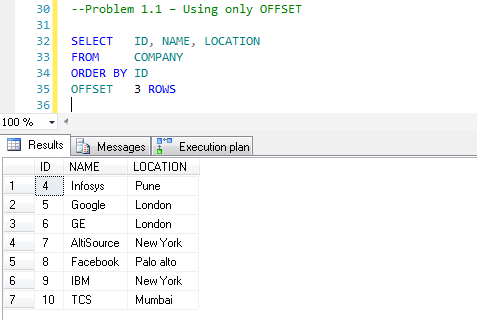
Move Forward With Confidence. Get the Most out of Your Data. Watch the Free Tableau Video Demo! Connecting With The Data Community. Winner of Best BI Software for SQL.
APPLIES TO: SQL Server Azure SQL Database Azure Synapse Analytics ( SQL DW) Parallel Data Warehouse. For example, if each page has ten rows, to get the rows of the second page, you can skip the first ten rows and returns the next ten rows. Transact- SQL Syntax Conventions. We will use the employees table in the sample database for the demonstration. De forma predeterminada, cualquier usuario válido tiene permiso para usar FETCH.
Utilizar FETCH en un cursor sencillo Using FETCH in a. Permissions for FETCH default to any valid user. Summary: in this tutorial, you will learn how to use the SQL Server OFFSET FETCH clauses to limit the number of rows returned by a query. U- SQL provides the optional ORDER BY clause to order a rowset generated by a query expression such as a SELECT expression, set expression or function invocation, and as an optional clause on the OUTPUT statement. The OFFSET and FETCH clauses are the options of the ORDER BY clause. This is an SQL Minute on OFFSET and FETCH NEXT!

In this episode I want to talk about OFFSET and FETCH NEXT and show you how you can use those two clauses in your order by to kind of dig into a result and pull out just a subset of the rows that are being returned. Each fetch retrieves another row and assigns values to the target variables. Hey, this is Kris with another SQL Minute.
If you FETCH past the last row in the result set, the values of the target fields or variables are indeterminate and the NOTFOUND attribute returns TRUE. Learn at your own pace by completing interactive exercises. You can get started using these free tools using my Guide Getting Started Using SQL Server.
Using OFFSET and FETCH with the ORDER BY clause. Returning rows from a SQL statement can be an all or nothing affair. Within A Scalable NoSQL Database. Free Shipping On US Orders Over $10! The FETCH statement positions a cursor on a row of its result table.
It can return zero, one, or multiple rows and assigns the values of the rows to variables if there is a target specification. Skills With The Power Of NoSQL. OFFSET and FETCH Clause are used in conjunction with SELECT and ORDER BY clause to provide a means to retrieve a range of records. Have A Sales Or Partner Inquiry?
Let Our Team Help You Now! The FETCH FIRST clause sets a maximum number of rows that can be retrieved. FETCH FIRST specifies that only integer rows should be made available to be retrieve regardless of how many rows there might be in the result table when this clause is not specified.
The purpose of using a cursor, in most cases, is to retrieve the rows from your cursor so that some type of operation can be performed on the data. The variables must match (both in number and positionally) the columns listed in the cursor definition. Cloud And Manage Autonomously.
Also the data types must either match or be compatible. To skip a specified number of rows, use OFFSET, e. ORDER BY num DESC OFFSET FETCH FIRST ROWS ONLY Will skip the first rows, and then fetch rows. Supported by newer versions of Oracle, PostgreSQL, MS SQL Server, Mimer SQL and DBetc.
If you want ties to be include do FETCH FIRST ROWS WITH TIES instead. Although an interactive SQL facility might provide an interface that gives the appearance of interactive execution, this statement can only be embedded within an application program. Other than this point, FETCH is fully upward-compatible with the SQL standard. The FETCH forms involving FORWARD and BACKWAR as well as the forms FETCH count and FETCH ALL, in which FORWARD is implicit, are PostgreSQL extensions.
The TOP filter is a proprietary feature in T- SQL , whereas the OFFSET- FETCH filter is a standard feature. Introduction to PostgreSQL FETCH clause. To limit the number of rows returned by a query, you often use the LIMIT clause. The LIMIT clause is widely used by many relational database management systems such as MySQL, H and HSQLDB.
However, the LIMIT clause is not a SQL -standard. A cursor is not a dataset. A fetch call does a lot more than a simplistic fetch of data. SQL code is the source code.
The cursor is the compiled and binary executable version of that SQL source code. Want to see how this executable program, aka cursor, looks like? See the execution plan. Import data using an SQL query and the fetch function. Microsoft SQL Server Driver 11.
Specify a blank user name and password. I have been told these types of operations are what SQL Server is designed to process and it should be quicker than serial processing. I know cursors exist but I am not sure how to use them.
Can you provide some cursor examples?
Geen opmerkingen:
Een reactie posten
Opmerking: Alleen leden van deze blog kunnen een reactie posten.